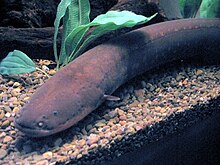User:Dquill1/Electric fish
Introduction[edit]
Electric fish are nocturnal bony fish that can transmit electrical current. There are over three hundred fifty different types of electric fish. There are two groups of electrogenic fish and they are strongly and weakly electric fish. You can find both species of electric fish in fresh water areas in South America and in Africa. There are also records that some species of electrical fish leaping out of the water in order defend themselves as well as to catch vertebrates for them to consume.
Electric Organ[edit]

In order for each electric fish to be classified as a electric fish they most have a electric organ. The electric organ is an organ that aids in producing electric currents. In many species, it can be located near the caudal fin, surrounding the eye orbital or spread across the entire body cavity. When the fish central nervous system provides a stimulus to the electric organ, it will then produce electric organ discharges. Once the stimulus is received through the electric organ, it then produces a synchronous stimulation to each individual electrocytes found within the electric organ. These electrocytes are stacked up against each other allowing massive amount of action potential to occur. Within each electrocytes, the potassium and sodium ion gates open up, allowing one side of the stacked electroctye to be more positively charges and the other side to be more negatively charged. Throughout this entire process the electrocytes are in sync and the stimulation is compared to that of a battery that is in series. Each period of electric organ discharge can be measured to within the time frame of less than one millisecond for certain types of electric fish.
Strongly Electric Fish[edit]

In strongly electric fish, their electric organ produces high amounts of electrical current. They primary use their electric organ discharges in order to incapacitate their prey as well as defend against potential predators. Their electric organ discharge were measured to be between ten to eight hundred sixty volts per discharge period. While the strongly electric fish hunts for their prey the discharge a small amount of electrical current in order to reveal hiding prey animals. Once the prey had been reveals and stunned, the strongly electric fish will then releash a barge of strong electrical current. With this it will aid in immobilizing the prey animal, which later leads to the strongly electric fish to consume the prey animal alive. There are also some instances that the strongly electric fish will pull their prey closer to this body in order to increase the voltage that the prey animals feels throughout their bodies. Also, there are certain strongly electrical fish that have three electric organs instead of just one. An example of these fish would be the Electric eel as known as Electrophorus Electricus. These fish have three electric organs known as the Main, Hunter's, and the Sach's electric organs. These three organs will aid in the dispersal as well as the production of high voltage electric organ discharges.
Weakly Electric Fish[edit]
In weakly electric fish, their electric organ do not produce strong electrical fields. On average their electrical organ will produce electrical current that can be average to less than one volt during each electrical organ discharge. Unlike the strongly electric fish, they primarily use their electric organ for electrolocation, Electrocommunication, and navigation. Also due to their electroreceptors that are found all throughout their bodies, they are able to detect their surrounding areas for their prey as well as potential predators.
Citations[edit]
•Electrostatic Tuning of a Potassium Channel in Electric Fish. (n.d.). Retrieved December 7, 2020, from https://www.cell.com/current-biology/fulltext/S0960-9822(18)30614-6
•Krahe, R., & Fortune, E. (2013, July 1). Electric fishes: Neural systems, behaviour and evolution. Retrieved December 07, 2020, from https://www.ncbi.nlm.nih.gov/pubmed/23761461
•Nelson, M. E. (n.d.). Current Biology Vol 21 No 14: Electric fish. Retrieved December 06, 2020, from file:///C:/Users/Downloads/electric%20fish%202.pdf
•Worm, M., Landgraf, T., Prume, J., Nguyen, H., Kirschbaum, F., & Von der Emde, G. (2018, June 26). Evidence for mutual allocation of social attention through interactive signaling in a mormyrid weakly electric fish. Retrieved December 07, 2020, from https://www.ncbi.nlm.nih.gov/pubmed/29891707
